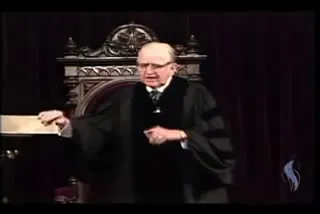
Cookbook Chronicles: The Paley’s Place Cookbook
Inspired chefs sharing their favorite ingredients, dishes and more.
View Transcript
[MUSIC PLAYING] The Restaurant Paley’s Place is located in Portland, Oregon. And we cook very much a Northwest cuisine with emphasis on local, locally produced and sourced and grown products. The same approach is reflected in our cookbook. So our recipes are very much rooted in what’s close to our homes as well as close to our hearts.
Yeah, the book is really focused on relationships to farmers, to purveyors, the winemakers. So as long as we’ve been out in Portland, Oregon, having moved from New York, we love it out there. And it’s a real great connection to all the farmers, purveyors, and growers. So those relationships have developed over time.
And the book carries that into some fun stories, some good reads. We wanted to get dirty in the kitchen. We wanted to get stained in the kitchen. But it also can be bedtime reading, because there’s some fun stories to read in the “Paley’s Place Cookbook” as well.
[MUSIC PLAYING]
Gosh, the inspirations come from all different places. And my inspiration for cooking basically came out of me not wanting to deal directly with the customers anymore. So I hid myself in the kitchen only to fall in love with cooking. The cooking itself was a long journey that started at the French Culinary Institute in New York City, took me and my wife Kimberly to France to really understand and really go deep into the roots of how preparation of food is done.
It becomes a way of life. It’s not just cooking anymore. It’s what you do. It’s how you live. It’s how your whole being reacts to all the food that’s around you. And the inspiration comes from the ingredients themselves. And that’s the philosophy we took back to the States, eventually traveling to Oregon, opening up our own restaurant. That’s the model that we’ve adopted is really using what’s around you to inspire you as to how you cook.
The first ingredient, perhaps, is a combination of the two ingredients. And it’s what the French call [FRENCH], which is a parsley and garlic chopped together. And that is my answer as part of the holy trinity of seasoning. So the other would be salt and pepper, and then something at the end that I would just add to the sauteed vegetables– a little roasted chicken with butter that you would just sprinkle with parsley and garlic together and just baste it.
The second ingredient would be [INAUDIBLE], and it’s my favorite spicy chili-style pepper that comes from the Basque region of France. And I love cooking with it. Just a little bit of it on some rabbit as you’re sauteing it or in a pork as you’re roasting it just really brings out. And then it works well together with my third favorite ingredient, and that would be fennel pollen.
[MUSIC PLAYING]
My comfort food is me sitting down drinking a martini while my wife is cooking, in the kitchen, our favorite taco salad that we love to enjoy so much.
Comfort food is really chilling out at home. Our comfort food and our style is basically not having to serve it, so to speak, in terms of all the customers and everything, which we love. And that’s our industry. But comfort food, to us, is cooking at home and eating the most simplest of things. And I make a great guacamole.
[MUSIC PLAYING]
I would probably want to be that very first sip of really cold gin martini with a twist made with Tanqueray 10. It’s my favorite. That’s what I would like to begin every meal with, and that’s what I look forward to the most. And so if I were– because that brings me the most joy in the whole meal. That starts out the whole thing. Looking forward to it, the actual sip, that would be my favorite thing to be.
[MUSIC PLAYING]
People that like to cook, people that have some kind of an idea, have a kitchen at home, have love for food. Some recipes are very easy to do. Some recipes are a bit more technical. But none of them are so difficult that require 34 steps with 34 sub-recipes and 50 different ingredients they can’t find. There is not a single recipe like that in the book. so they’re all very accessible, even the most difficult ones from scratch.
We also try to keep recipes down to, say, one page. A lot of times, the dealbreakers for people are it’s two pages. It’s too long. We’re not even going to look at it.
That’s usually mine.
So I want to– there’s some more technical recipes that will require certain sub-recipes to perform. But my mission in this book is not to take you out of the kitchen. It’s to bring you back into the kitchen. And so if I’m going to profess wholesome, nutritious meal, it’s not just the food itself or the recipe itself. It’s the process of cooking that brings joy and hopefully a great eating result after that.
[MUSIC PLAYING]










